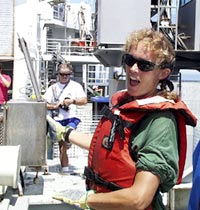|
|
Interviews: Geochemist Karen Harpp How did you become interested in geology? Karen: I had an awesome high school teacher who taught beyond what he had to teach for the provincial curriculum. In Montreal, where I grew up, it is really flat except for a few obvious mountains. Well, we called them mountains. Other people might call them hills. But they were really old volcanic necks. Our teacher explained that the volcanic neck is more resistant than the surrounding sediment that made up the river valley, so it erodes slower - like a rock buried in sand. Wind will continuously change the sculpture of the sand around the rock, but the rock stays the same for a long time. Then I could look at Mount Royal and say, ‘I know why that's there.’ I went to college at Dartmouth to be a geologist, but I took a chemistry class at my father’s request, he’s an organic chemist. I had such a fabulous teacher I changed my major. Now I use chemistry as a tool to figure out geologic puzzles. Question: It sounds like you’ve had a number of great teachers, did that influence your decision to teach? Karen: I think that’s key, having great teachers. It also runs in my family. Both my parents are fabulous teachers. My father is a great innovator of ways to teach science. My mom uses her teaching ability in community welfare in Canada. For instance, she helps people become self-supporting by starting their own business. My sister, Emily, is two years younger than me and teaches English and Drama outside of Los Angeles. She’s the one with all the imagination. When we were growing up, she would think of the stories we would act out and I would be the logistics coordinator.
What has been some of your most challenging experiences? Karen: No doubt, fieldwork with Denny Geist. The first time we worked together was in 1997, on Volcán Ecuador. I was a professor at Lawrence University. I had never done fieldwork in the Galápagos before. It was challenging in many ways. Here we were on the equator, hanging off the sides of cliffs, in the middle of nowhere in a place that looks like the moon. It was different from anything I had ever done before. I’ve done it since, and I love it. Denny has also been getting me in trouble ever since. In 1998, we organized a conference in the Galápagos with 65 geologists. Herding geologists on volcanoes is almost impossible, because they always want to go off the path and look at stuff. The meeting was a huge hit. Last summer Denny and I went on a field trip to Indonesia to look at Krakatoa volcano. The organizers oversubscribed the trip and we had about 50 people in a boat that was supposed to hold 20. At night we had no space to sleep on board, so they set up a tent on an island facing Krakatoa. Denny and I and a few other people thought we would sleep on the beach. It was beautiful, the stars were out and we could see Krakatoa rumbling in the distance. The volcano would erupt with steam and ash about every hour. Then it started to rain, but only a light shower and in 10 minutes it stopped. Then just as we were falling asleep the rain came ripping down in buckets. At 2 a.m. we were soaked to our skin, walking along the beach with monitor lizards and picking off tiny crabs that had crawled into our hair while we were on the sand. It was so absurd we were doing this, all I could do was laugh. And there’s no way I’d have done that if I hadn’t gotten to know Denny on Volcán Ecuador, in the Galápagos.
What do you enjoy doing when you’re not working? Karen: My partner, David Baird, and I have two dogs we take hiking, biking, cross-country skiing and running. One’s a Husky named Skeena and the other is an Australian shepherd mutt named Hudson. They’re both named after rivers in Canada. Hudson is a ‘Velcro’ dog; he sticks with you everywhere you go. But Skeena has a turning radius of two miles. Sometimes she doesn’t come back and we have to go find out what new trouble she’s gotten into. Question: What about Galápagos volcanoes do you find most interesting? Karen: The little islands to the north - Genovesa, Marchena, Pinta, Wolf and Darwin - are the oddballs in the archipelago. I’m working on a project to try and figure out how these little volcanoes are related to the hot spot or if in fact they are related to the mid-ocean ridge north of here. I’m wondering if the combination of the hot spot and the Galápagos Spreading Center creates extra volcanism you wouldn’t get with only the hot spot or the ridge. These volcanoes are all sitting between two mantle fires. |
||||||
Mailing List | Feedback | Glossary | For Teachers | About Us | Contact
© 2010 Dive and Discover™. Dive and Discover™ is a registered trademark of
Woods
Hole Oceanographic Institution

 After the end of a watch, Karen, Denny Geist and Alberto Saal discuss
Galápagos geology and reminisce about adventures in the field.
After the end of a watch, Karen, Denny Geist and Alberto Saal discuss
Galápagos geology and reminisce about adventures in the field.
